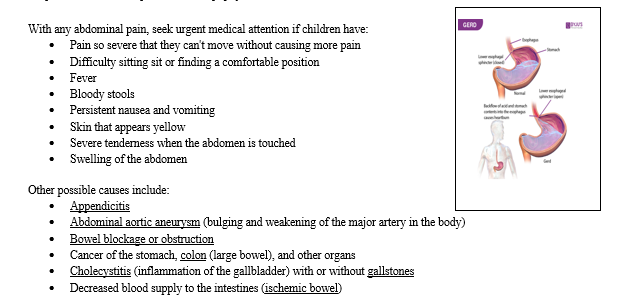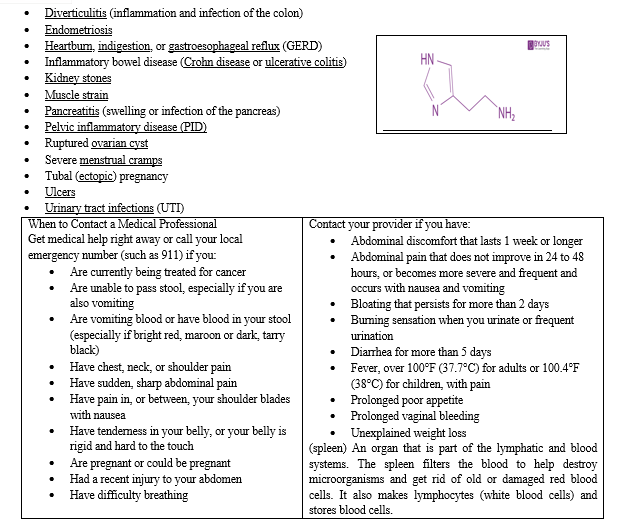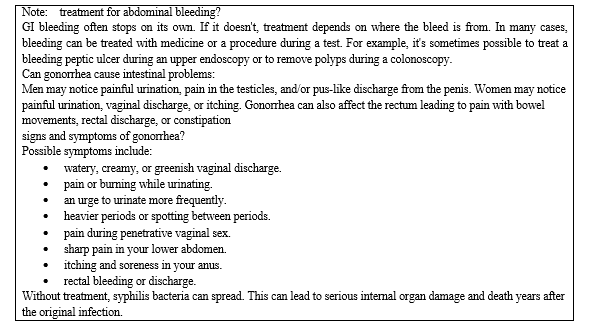Ijraset Journal For Research in Applied Science and Engineering Technology
- Home / Ijraset
- On This Page
- Abstract
- Introduction
- References
- Copyright
A Case Study of Diagnosis & Treatments How is Functional Abdominal Pain Diagnosed?
Authors: Dr. Chilakalapudi Meher Babu
DOI Link: https://doi.org/10.22214/ijraset.2024.63790
Certificate: View Certificate
Abstract
Vacuum levels are commonly measured in terms of in. Hg (inches of mercury), mm Hg (Torr), and microns. We monitor motor cortical excitability, brain stimulation-induced neuroplasticity. The most common causes of abdominal pain and diarrhea are infections, such as gastroenteritis (stomach flu), and food allergies, lactose intolerance, and stress. Common bowel disorders, such as IBS and Crohn\'s disease, can also cause these symptoms. Viral gastroenteritis is an infection of your intestines that typically causes watery diarrhea, pain or cramping in your abdomen, nausea or vomiting, and sometimes fever. People commonly call viral gastroenteritis “stomach flu,” but the term is not medically correct. Flu viruses do not cause viral gastroenteritis. The most common symptom of chronic pancreatitis is long-standing pain in the middle of your abdomen. If you have chronic pancreatitis, you might get repeated episodes of acute pancreatitis, where your pain gets worse. Your pain may get worse with eating, drinking and drinking alcohol. You may also develop jaundice.
Introduction
I. INTRODUCTION
Usually, the pain is located around the umbilicus (belly button), however the pattern or location of abdominal pain is not always predictable. The pain may occur suddenly or slowly increase in severity. The pain may be constant or may increase and decrease in severity. Some children with functional abdominal pain may experience dyspepsia, or upper abdominal pain associated with nausea, vomiting, and/or a feeling of fullness after just a few bites (early satiety). Others may experience abdominal pain with bowel movements. Pain that is usually relieved by bowel movements, or associated with changes in bowel movement habits (mainly constipation, diarrhea, or constipation alternating with diarrhea) is the classic irritable bowel syndrome (IBS).
II. CAUSES
The trigger for functional abdominal pain varies from one patient to another, and may transform over time even in the same patient. The exact triggers may not be easily identified but may remain moving targets for treatment. Nerve signals or chemicals secreted by the gut or brain, may cause the gut to be more sensitive to triggers that normally do not cause significant pain (such as stretching or gas bloating). Because of this change in bowel function, this type of abdominal pain is often referred to as “functional abdominal pain.”
Most young children will point to the umbilicus (belly button) when asked to describe the location of abdominal pain. However, pain centered around the belly button could be due to a number of causes that should be considered when evaluating a child with chronic abdominal pain. Some of those causes are not very serious while other causes require close and long term care. Possible causes that should be considered based on the history, physical examination and testing, are acid reflux, constipation, lactose intolerance, parasitic infections of the small and large intestines, infections of the stomach with a germ called Helicobacter pylori (that is associated with ulcers in the first portion of the small bowel), inflammatory bowel diseases (IBD) such as Crohn’s disease and ulcerative colitis, celiac disease which is a sensitivity to cereal grains, food allergies, inflammation of the liver (hepatitis), gall bladder problems, an inflamed pancreas, an intestinal obstruction (blockage), appendicitis, and many more rare disorders. It must be emphasized that typically, none of these more severe problems cause abdominal pain in most children with chronic or recurrent bellyaches. Instead, the pain is usually “functional”. A child with functional abdominal pain may also suffer from multiple, interrelated problems, such as: Heightened sensitivity to light, sound, or diet,Fatigue or sleep disorders Anxiety and depression, Headaches,Nausea, Joint pain, Muscle contractions in the intestine, Nervous system, Severe infection, Early life stress, Changes in gut microbes.

A. Risk Factors
In some cases, children previously suffering from anxiety, depression and other psychiatric disorders may show an exaggerated pain response. Sometimes, the parent and the child may not be consciously aware of any stress or emotional disturbances. Other possible risk factors are thought to be physically or emotionally traumatic experiences, and preceding gastrointestinal infections. Parents and children need to be reassured that functional abdominal pain is not life threatening. However, functional abdominal pain may have negative effects on the child’s physical and psychological state. The pain may interfere with school attendance, participation in sports and other extra-curricular activities. Infrequently, it may affect appetite and sleep. The changes in the daily routine may affect the child’s mood and emotions, and in turn cause depression and anxiety.
B. Screening/Diagnosis
Detailed information regarding the location of abdominal pain, the frequency (number of times per week) and duration of a typical episode, and association with other complaints will in most cases provide useful clues about the cause, and will guide further testing. Other important pieces of information, known as “red flags” or “alarm signs” that a physician may inquire about include weight loss, poor growth, fever, joint pains, mouth ulcers, unusual rashes, loss of appetite, blood that appears in the vomiting or stool, and night time awakening due to diarrhea and abdominal pain. The doctor will also ask about the effects of foods and beverages upon the pain, and relationship to stools, sleep, physical activities, and emotional stress.


III. HOW TO UNDERSTANDING MENSTRUATION CYCLE PAIN PERIOD?
Each menstruation cycle has specific days where the chances of getting pregnant are maximum. If the sperms are available to meet the mature egg released on the ovulation day, the chances of pregnancy are high. Before we go through the exact ovulation days calculations, the following are a few things to understand.
Sperms active duration: Sperms can stick in the fallopian tubes for up to several days, typically about three to six days.
Eggs active duration: The egg has only 12 to 24 hours of life.
Considering the above, technically, the fertility window is four days before ovulation, the day of ovulation, and one day after ovulation. So, technically, it's six days of the ovulation period. But the best fertile days are two days before ovulation day and the ovulation day. So, the best fertile days are the three days, two days before ovulation, and the day of ovulation. This ovulation calculator considers this principle while calculating the results.
Following are some quick examples of how to estimate the best fertility period:
For the average menstruation cycle of 28 days, the ovulation day is day 14. The best fertility
period is days 12, 13, and 14.
For the average menstruation cycle of 35 days, the ovulation day is day 21. The best fertility period is days 19, 20, and 21.
For the average menstruation cycle of 21 days, the ovulation day is day 7. The best fertility period is days 5, 6, and 7.
Remember that most women have irregular periods. So, it is hard to estimate the ovulation day. To avoid the odds in these calculations and increase the chances of pregnancy, it is good to have sex every 2-3 days during your ovulation period.
Estimating the cycle length is essential to understand your ovulation days and ovulation period. This is one of the inputs asked by this ovulation calculator. As most women have irregular cycles, it is better to work out an "average" cycle length based on at least the span of three menstrual cycles. For example, your October to December cycle lengths is:
October: 30 days, November: 27 days, and December: 31 days.
Average cycle length =( 30 + 27 + 31 ) / 3 = 29 days.
Keeping an eye on your body's behavior might be the only way out. Your body behaves a little differently when you are ovulating. You can pay attention to the following signs and know when you are ovulating:
- Your basal body temperature increases slightly, about 1/2 to 1 degree.
- Your cervical mucus or discharge may appear clearer, thinner, and slippery like raw egg whites.
- Your breast may become tender.
- Your cervix softens and opens.
- You may feel slight cramps or twinges in your lower abdomen.
- You may experience a mild spotting.
- You may experience an elevated sense of smell.
- You may experience little change in appetite or mood swings.
- Your sex drive may increase.
A cesarean section, or C-section, is surgery to deliver your baby through a cut, called an incision, made in your lower belly and uterus. You may have some pain in your belly and need pain medicine for one to two weeks. You can expect some vaginal bleeding for several weeks.
Abdominal or tummy pains may have a number of causes after the birth of your baby. The most common causes are after pains, UTIs (urinary tract infection - an infection of your bladder or kidneys resulting in pain when you pee) , an infection in your womb (uterus), or pain following a caesarean section.
Stool may look black or tarry. Bleeding can range from mild to severe and can be life-threatening. Imaging technology or an endoscopic investigation can usually locate the cause of the bleeding. Treatment depends on the where the bleeding is located and how severe it is.


References
[1] Giarratano, J. and G. Riley.(2004). Expert Systems:Principles and Programming, Fourth Edition. Boston, MA, Thomson/PWS Publishing Company. ISBN: 0534937446. [2] Russell, S. and P. Norvig, (2002). Artificial Intelligence: A Modern Approach, Prentice Hall, Englewood Cliffs, NJ, Second Edition. ISBN 0-13-103805-2. [3] Family doctor , https://familydoctor.org/your-health-resources/health-tools/symptom-checker/, datae visited 05/03/2017 [4] Wikipedia , http://wikipedia.org [5] Abu Naser, S. (1993). A methodology for expert systems testing and debugging. (Ph.D.), North Dakota State University, USA, USA. [6] Abu Naser, S. S. (1999). Big O Notation for Measuring Expert Systems complexity. Islamic University Journal - Gaza, 7(1), 57-77. [7] Abu Naser, S. S. (2015). Sl5 Object: Simpler Level 5 Object Expert System Language. International Journal of Soft Computing, Mathematics and Control (IJSCMC), 4(4), 25-37. [8] Abu Naser, S. S., & Abu Hasanein, H. A. (2016). Ear Diseases Diagnosis Expert System Using SL5 Object. World Wide Journal of Multidisciplinary Research and Development, 2(4), 41-47. [9] Abu Naser, S. S., & Abu Zaiter, O. A. (2008). An Expert System For Diagnosing Eye Diseases Using Clips. Journal of Theoretical & Applied Information Technology, 4(10). [10] Abu Naser, S. S., & Akkila, A. N. (2008). A Proposed Expert System for Skin Diseases Diagnosis. Journal of Applied Sciences Research; www.aensiweb.com/JASR/, 4(12), 1682-1693. [11] Abu Naser, S. S., & Alawar, M. W. (2016). An expert system for feeding problems in infants and children. International Journal of Medicine Research, 1(2), 79-82. [12] Abu Naser, S. S., & Al-Bayed, M. H. (2016). Detecting Health Problems Related to Addiction of Video Game Playing Using an Expert System. World Wide Journal of Multidisciplinary Research and Development, 2(9), 7-12. [13] Abu Naser, S. S., & AlDahdooh, R. M. (2016). Lower Back Pain Expert System Diagnosis And Treatment. Journal of Multidisciplinary Engineering Science Studies (JMESS), 2(4), 441-446. [14] Abu Naser, S. S., & Alhabbash, M. I. (2016). Male Infertility Expert system Diagnoses and Treatment. American Journal of Innovative Research and Applied Sciences, 2(4). [15] Abu Naser, S. S., & Al-Hanjori, M. M. (2016). An expert system for men genital problems diagnosis and treatment. International Journal of Medicine Research, 1(2), 83-86. [16] Abu Naser, S. S., & ALmursheidi, S. H. (2016). A Knowledge Based System for Neck Pain Diagnosis. World Wide Journal of Multidisciplinary Research and Development (WWJMRD), 2(4), 12-18. [17] Abu Naser, S. S., & Al-Nakhal, M. A. (2016). A Ruled Based System for Ear Problem Diagnosis and Treatment. World Wide Journal of Multidisciplinary Research and Development, 2(4), 25-31. [18] Abu Naser, S. S., & Bastami, B. G. (2016). A Proposed Rule Based System for Breasts Cancer Diagnosis. World Wide Journal of Multidisciplinary Research and Development, 2(5), 27-33. [19] Abu Naser, S. S., & El Haddad, I. A. (2016). An Expert System for Genital Problems in Infants. EUROPEAN ACADEMIC RESEARCH, 4(10). [20] Abu Naser, S. S., & El-Najjar, A. E. A. (2016). An expert system for nausea and vomiting problems in infants and children. International Journal of Medicine Research, 1(2), 114-117. [21] Abu Naser, S. S., & Hamed, M. A. (2016). An Expert System for Mouth Problems in Infants and Children. Journal of Multidisciplinary Engineering Science Studies (JMESS), 2(4), 468-476. [22] Abu Naser, S. S., & Hilles, M. M. (2016). An expert system for shoulder problems using CLIPS. World Wide Journal of Multidisciplinary Research and Development, 2(5), 1-8. [23] Abu Naser, S. S., & Mahdi, A. O. (2016). A proposed Expert System for Foot Diseases Diagnosis. American Journal of Innovative Research and Applied Sciences, 2(4), 155-168. [24] Abu Naser, S. S., & Shaath, M. Z. (2016). Expert system urination problems diagnosis. World Wide Journal of Multidisciplinary Research and Development, 2(5), 9-19. [25] Abu Naser, S. S., & Zaqout, I. S. (2016). Knowledge-based systems that determine the appropriate students major: In the faculty of engineering and information technology. World Wide Journal of Multidisciplinary Research and Development, 2(10), 26-34. [26] Abu Naser, S. S., Alamawi, W. W., & Alfarra, M. F. (2016). Rule Based System for Diagnosing Wireless Connection Problems Using SL5 Object. International Journal of Information Technology and Electrical Engineering, 5(6), 26-33. [27] Abu Naser, S. S., Baraka, M. H., & Baraka, A. (2008). A Proposed Expert System For Guiding Freshman Students In Selecting A Major In Al-Azhar University, Gaza. Journal of Theoretical & Applied Information Technology, 4(9). [28] Abu Naser, S., & Aead, A. M. (2013). Variable Floor for Swimming Pool Using an Expert System. International Journal of Modern Engineering Research (IJMER), 3(6), 3751-3755. [29] Abu Naser, S., Al-Dahdooh, R., Mushtaha, A., & El-Naffar, M. (2010). Knowledge management in ESMDA: expert system for medical diagnostic assistance. AIML Journal, 10(1), 31-40. [30] Abu-Naser, S., El-Hissi, H., Abu-Rass, M., & El-Khozondar, N. (2010). An expert system for endocrine diagnosis and treatments using JESS. Journal of Artificial Intelligence; Scialert, 3(4), 239-251. [31] Abu-Naser, S., Kashkash, K., & Fayyad, M. (2010). Developing an expert system for plant disease diagnosis. Journal of Artificial Intelligence ; Scialert, 3(4), 269-276.
Copyright
Copyright © 2024 Dr. Chilakalapudi Meher Babu. This is an open access article distributed under the Creative Commons Attribution License, which permits unrestricted use, distribution, and reproduction in any medium, provided the original work is properly cited.

Download Paper
Paper Id : IJRASET63790
Publish Date : 2024-07-28
ISSN : 2321-9653
Publisher Name : IJRASET
DOI Link : Click Here
 Submit Paper Online
Submit Paper Online

